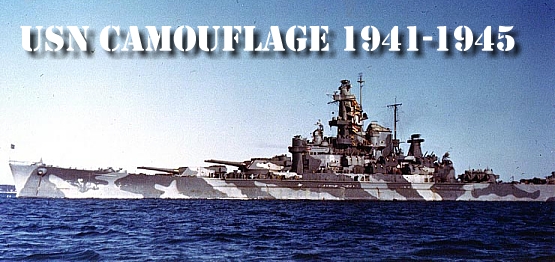
An online database of camouflage used by
United State Naval Warships during WWII
|
|
|
The
Development of Naval Camouflage 1914 - 1945 By
Alan Raven (Article reprinted courtesy of Plastic Ship Modeler Magazine issue #97/2) With
the advent of peace in the last weeks of 1918 all camouflage was dispensed with
and by early 1919 every warship had reverted to peacetime colors.
Vertical surfaces of every class were now painted in light gray (Standard
Navy Gray #5) and horizontal surfaces (except those with wood planking) were #20
Deck Gray (a very dark neutral gray). The
subject of camouflage and ship concealment by painted means remained dormant
until 1934 when the subject was raised and discussed in a technical paper from
the Naval Research Laboratory. Discussion
was mainly about problems of visibility measurement, haze factors weather
conditions, light, etc. No
definitive conclusions were reached and the matter was dropped until September
of the following year. Then the
same ground was covered, with the addition of consideration being given to
reducing a ship's visibility when seen from the air. The paper ended by suggesting that two destroyers be selected
for experiments when viewed from aircraft.
One would have the standard light gray hull and dark gray decks, the
other to have dark gray decks with the vertical surfaces painted a medium blue
gray. Observations were to be made from the surface and from the air, during
daylight and nighttime hours. The
tests were conducted in November and December off San Diego on five destroyers
of divisions 5 and 18. The ships
were SOUTHARD, HALE, CROWNINSHIIELD, AARON WARD, and HOVEY. A
variety of schemes were tried ranging from solid tones of light gray to black,
graded patterns, and the breaking up of features with contrasting patterns. (See
Fig. 1 and 2) As with experiments
of a similar nature conducted prior to and during WW I, no definite conclusions
were arrived at, except that no one type of scheme performed well under all
conditions. The report concluded by
recommending further experiments, which were performed in late December with
similar conclusions being reached. Fig.
1 USS CROWNINSHIELD.
Fig.2
USS HALE.
Interest
in camouflage was sustained by the two series of experiments to the point where
from April to July 1936 a series of Dazzle designs were painted onto models and
the results observed in a laboratory. Opinion
was that some of the designs achieved disruption and promoted a false heading
and some did not, and almost ALL Produced enhanced visibility. On
the question of observation from the air, this had special relevance for
submarines, on which inconclusive experiments were conducted in the 1934-1936
period. In December 1936 the
Commander of the Submarine requested a series of further experiments to be
conducted along more scientific lines. Up
to this time the standard colors for submarines had been an overall light gray,
not the best for promoting concealment on or just under the water when viewed
from the air, especially in clear tropical waters. The
tests were conducted in mid 1937 in deep waters off Pearl Harbor, four
submarines (SS21, SS22, SS28, and SS35) taking part, each painted a different
color. SS28 was overall black, SS35
overall dark blue/gray, and SS21 was overall dark purple.
A second series of tests used a disruptive pattern of black and green on
SS21 and black, blue and green on SS35. In
a third experiment the SS22 was painted in a disruptive pattern of dark blue and
black. Results
suggested that the best color for concealment from the air in areas where the
water was clear was the dark blue and it was suggested that further tests he
carried out. The Commander of
Submarines agreed and Commander Submarine Squadron Four ordered the boats of
Submarine Division Eight to be painted overall dark blue. The author believes
this was done in the first weeks of 1938 upon delivery of the required stocks of
paint. A
second series of tests were carried out during June and July 1938 by Submarine
Squadron Six in the San Diego area. Four boats were painted as follows; SS
PERCH - Overall light greenish gray. It
was concluded that black gave the best results, even over the dark blue that was
judged better in the Pearl Harbor tests, and that further experiments would he
valuable. A
third series of tests were performed, this time in the Panama area, using very
dark blue and black - results inconclusive, mainly because the blue turned
"milky" becoming a much lighter tone after application. A
fourth series of tests were performed, this time off Key West, Florida, in
February 1940. The vessels taking
part were SCULPIN (Pearl Harbor Blue) and SPEARFISH (Black).
When seen on the surface in fine weather there was no discernable
difference between the two colors. When
submerged the blue was less visible than the black.
Prior to these tests it was discovered that the dark blue used in the
1938 San Diego tests was not the same blue used in the 1937 tests at Pearl
Harbor. The blue used in 1938 was lighter in tone and slightly purple
in color, hence the different conclusions. Because
of a problem of durability of the blue paint (over that of the black) the black
was chosen to he applied to all submarines in the Atlantic and Pacific fleets.
By the end of 1940 this had been accomplished. The series of submarine camouflage experiments in the late thirties had been matched by a similar series dealing with surface ships. The first of these tests were conducted in May and June 1938 in the San Diego area using the four ships of Destroyer Division Five, CASSIN, CONYNGHAM, REID, and DOWNES. All four were painted in different low visibility schemes, three of which were of a graded type. (See Figs. 3,4, and S.) A second run of tests using disruptive patterns was applied |